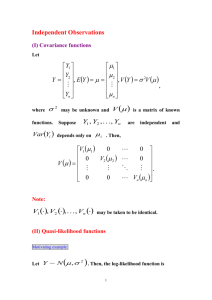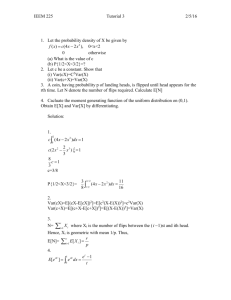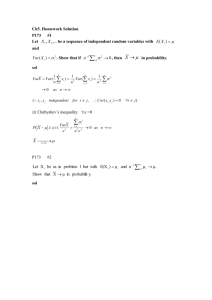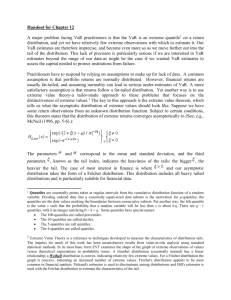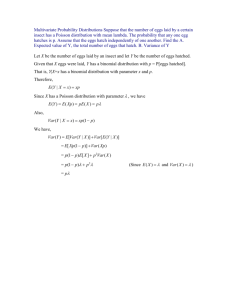Notes
advertisement
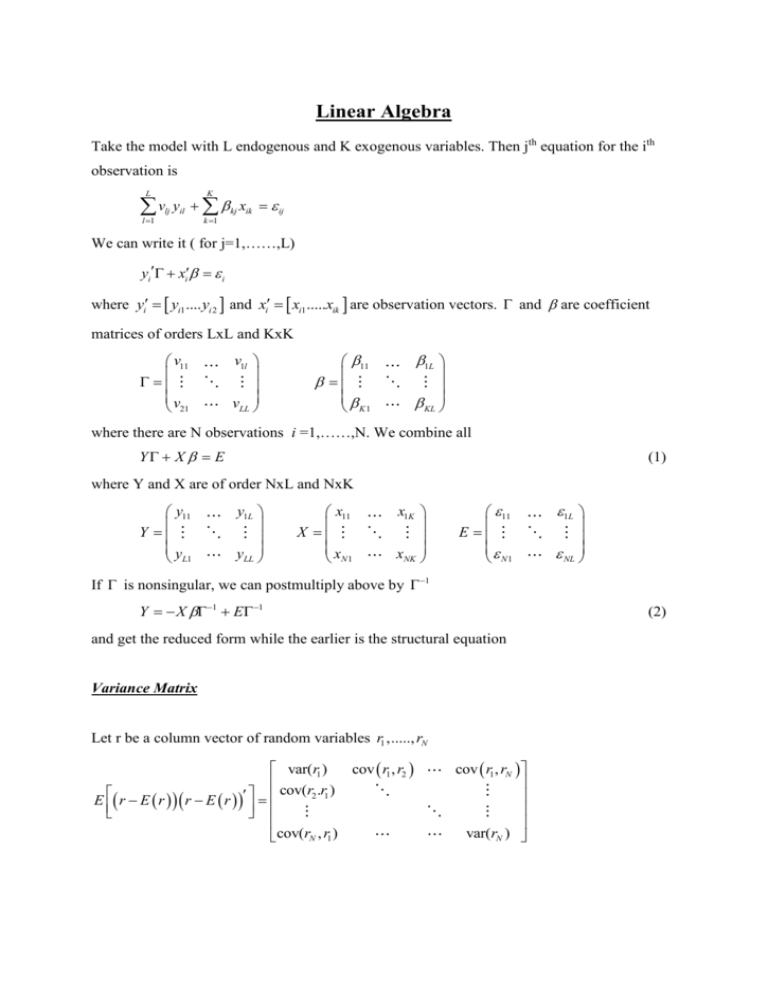
Linear Algebra Take the model with L endogenous and K exogenous variables. Then jth equation for the ith observation is L K l 1 k 1 vlj yil kj xik ij We can write it ( for j=1,……,L) yi xi i where yi yi1 .... yi 2 and xi xi1 .....xik are observation vectors. and are coefficient matrices of orders LxL and KxK v11 v 21 v1l vLL 11 K1 1L KL where there are N observations i =1,……,N. We combine all Y X E (1) where Y and X are of order NxL and NxK y11 Y y L1 y1L yLL x11 X x N1 x1K xNK 11 E N1 1L NL If is nonsingular, we can postmultiply above by 1 Y X 1 E 1 (2) and get the reduced form while the earlier is the structural equation Variance Matrix Let r be a column vector of random variables r1 ,....., rN var(r1 ) cov r1 , r2 cov(r2 .r1 ) E r E r r E r cov(rN , r1 ) cov r1 , rN var(rN ) Least Squares y x b x x x y 1 (3) because ee y y 2 y xb bx xb is minimized by changing b. b x x x 1 if E is 0 and x is nonrandom, then b is unbiased. var(b) x x x var x x x 2 x x 1 1 1 since var 2 . Substitution of (3) into e y xb yields the protection matrix e My , where M is symmetric and idempotent. M I X X X X 1 since MX=0, e My M x M . Also M 2 =M, causing the residual sum of squares ee M M M 2 ee M Trace: The trace of a square matrix is the sum of its diagonal elements tr(AB) = tr(BA) if both exist tr(A+B) = tr(A)+tr(B) if they are of same order example: E ee E M trE M = tr E trX X X XE 1 2 tr 2 tr X X X X 1 2n 2k 2 n k Generalized Least Squares If cov 2 v rather than 2 where v is nonsingular then ˆ xv 1 x xv 1 y 1 and 1 var ˆ 2 x v 1 x (derived later in Aitken`s Theorem) Partitioned matrices: Take the system in (2) and rewrite it as Y Y1Y2 y13 y12 Y2 yn3 yn 2 y11 y12 Y1 yn1 yn 2 We partition by sets of columns. Rules: A11 A 21 A12 B11 A22 B21 B12 A11 B11 B22 A21 B21 A11 B11 A12 B21 A21 B11 A22 B21 A B A12 B12 A22 B22 A11 B12 A12 B22 A21 B12 A22 B22 Inverse of a symmetric partitioned matrix: 1 D DBC 1 A B 1 B C 1 1 1 C BD C C BDBC A1 A1BEBA1 A1BE = EBA1 E where D A BC 1 B and E C B A1 B . We use the first when C is nonsingular and 1 second when A is nonsingular. Application: deviation from mean i i x i ix x x bottom right of inverse X MX 1 1 M ii n Kronecker Product A special form of partitioning when all submatrices are scalar multiples of the same matrix. a11 B A B am1 B a1n B amn B We refer to this as Kronecker product of A and B. If B is pxq, then the order is mpxnq A B C D AC BD 1 A B A1 B 1 since A B A1 B 1 AA1 BB 1 A B A1 B 1 A B C A B A C B C A B A C A 1 Application: Joint GLS yj xj j j X1 0 y1 0 y2 0 j=1,......,L for L endogenous variable 0 0 1 1 0 X L L L Y Z If we assume n disturbances of L equations have equal variance and uncorrelated so that var( j ) jj I and for j i E ( j i ) contains contemporaneous covariances, then the full covariance matrix 11 I 12 I I I 22 var( ) 21 L1 I 1L I I LL I where Assuming is non-singular, application of GLS results in ˆ ( Z ( 1 I ) Z ) 1 Z ( 1 I ) y and var(ˆ ) Z (1 I ) Z 1 ̂ is superior to Least Squares unless X i are all identical causing j1 X 0 Z 0 0 X 0 0 IX 0 X Z ( 1 I ) Z ) ( I X )( 1 I )( I X ) 1 ( X X ) var GLS var OLS or is diagonal, indicating no covariance between j and i. Vectorization Sometimes we need to work with vectors rather than matrices, e.g. finding the variance of k . If the ’s are in a matrix form B. Therefore, we vectorize these parameters by: A= a1 .........aq (a pxq matrix), ai being the i’th column of A. vec(A) = a1 a2 aq which is a pq element column vector. vec(A+B) = vec(A)+vec(B) vec(AB)= ( I A)vec( B) ( B I )vec( A) Definiteness If the quadratic form xAx is positive for any x 0 is said to be positive definite. The covariance matrix of any random vector is always positive semi definite. Example: BLUE implies Var ( ) var(b) is positive semi definite. Proof: is linear in y so = y . Define C = B - ( X X ) X To write y as C ( X X ) 1 X y C ( X X ) 1 X X =(CX I ) + C ( X X )1 X Unbiasedness implies CX = 0. var( ) C ( X X ) 1 X var( ) C ( X X ) 1 X = 2CC 2 ( X X ) 1 2 CX ( X X ) 1 2 ( X X ) 1 X C 0 0 The difference 2 CC is positive semi definite because 2 wCC w ( C w)( Cw) is the non-negative squared length of the vector Cw (inner product). We use definiteness in evaluation of minima and maxima; e.g. for maximizatior of utility the Hessian should be negative definite. If a matrix is definite and black diagonal, the principal submatrices are also definite. Diagonalization For some nxn matrix A, we seek a vector x so that Ax equals x ( is a scalar) This is trivially satisfied by x = 0 so we impose xx 1 implying x 0 . Ax x ( A I ) x 0, xx 1 (4) A I is singular A I 0 (characteristic equation) If A is diagonal, then the terms in the diagonal will be the solution to the characteristic eq. The determinant is a polynomial of degree n and has i as the latent roots. The product of i equals the determinant of A, and the sum i equals the trace of A. All vectors are called characteristic (eigen)vectors. If A is symmetric x Ay y Ax , so assume i and j are two different roots with vectors xi and x j . Premultiplying Axi i xi by x j and Ax j by xi and then subtract x j Axi xiAx j (i j ) xix j For a symmetric matrix, left side vanishes and (i j ) is non zero, implying orthogonality of the characteristic vectors. X X I where X x1 x 2 ......xn AX= Ax1 Ax 2 .....Ax n 1 x1.......n xn AX X where is diagonal with i on the diagonal. Premultiply by X X AX X X This double multiplication diagonalizes A (symmetric). Also postmultiplication n AXX A X X i X i X i i 1 Special cases: If A is square Ax x A2 x Ax 2 x which shows that the roots of a square matrix A2 is the square of . For symmetric and non singular A premultiply both sides by ( A) 1 to obtain A1 x 1 x All latent roots of a positive definite matrix are positive. Aitken’s theorem: Any symmetric positive definite matrix A can be written as A QQ where Q is some nonsingular matrix. For example, consider the covariance matrix 2V . This matrix is positive def. So its inverse also is. So we can decompose it V 1 QQ . We premultiply both sides of y X by Q Qy (Q X ) Q (QX )(QX ) (Q X )Q y ( X QQ X ) 1 X QQy 1 ( X V 1 X )1 X V 1 y (GLS) var( Q) 2 QVQ 2 Q(QQ)1 Q 2 QQ 1Q 1Q 2 I Cholesky decomposition Rather than using an orthogonal matrix, X, in the previous diagonalization, it is also possible to use a triangular matrix. For instance, consider a diagonal D and an upper triangular C with units in the diagonal. 1 C12 C 0 1 0 0 C13 C23 1 d1 0 D 0 d 2 0 0 0 0 d3 yielding d1 C DC d1c12 d1c13 d1c12 d c d2 d1c12c13 d 2c23 2 1 12 d1c12c13 d 2c23 2 d1c132 d 2c23 d3 d1c13 Any symmetric positive definite matrix A aij can be uniquely written as CDC (d1 a11 , c12 a12 a11 , etc.) , which is referred to as the Cholesky decomposition. Simultaneous diagonalization of two matrices ( A B) x 0 xBx 1 (5) where A and B are symmetric nxn matrices, is being positive definite. B1 is also positive def. So B 1 QQ . (QAQ I ) y 0 yy 1 y Q-1 x This shows that (5) can be reduced to (4) when A in (4) is interpreted as Q AQ . If A is symmetric, so is Q AQ . (5) has n solutions 1 ...........n , and if they are distinct, then X i are unique. ( A B) x 0 as Axi Bxi and AX BX premultiplication by X X AX X BX Therefore X AX and X BX I which shows that matrices being diagonalized together, A into the latent root matrix and B into I. Example: Constrained extremum Maximize xAx subject to xBx 1 with respect to x Lagrangian x AX ( x Bx 1) L 2 Ax 2 Bx Ax Bx x which shows that must be a root. Next premultiply by x x Ax x Bx shows that the largest root i is the maximum of xAx st xBx 1 Principal components Consider nxk observation matrix Z. The objective is to approximate Z by a matrix of unit rank, vc , where V is an n element vector and C is a k element coefficient vector. The objective is to minimize the discrepancy matrix Z vc by minimizing the square of all KN discrepancies and also impose vv 1 to be able to solve for c. The solution when v v1 and c c1 is ( ZZ 1 I )v1 0 c1 Z v1 So 1 is the largest latent root of ZZ . Next to approximate Z by v1c1 v2 c2 , we again minimize the discrepancies st. v2 v2 1 and v2 v1 0 . The solution again is ( ZZ 2 I )v2 0 c2 Z v2 which is the second largest root and the corresponding vector. You can generalize to i roots. Derivation for 1 root Since the sum of squares of any matrix A is equal to trace AA , the discrepancy matrix sum of squares is tr Z vc Z vc trZ Z trcvZ trZ vc trcvvc inner products since c=vZ trZ Z 2v Zc v v c c trZ Z 2v Zc c c Derivative wrt c is 2Z v 2c c Z v Substituting this back in, we get trZ Z vZZ v , so to minimize the discrepancy, maximize vZZ v wrt v st vv 1 Langrangian vZZ v vv 1 ZZ v v v ZZ v v v This, shows that the maximum root, , minimizes ZZ . Extend to i cases. Z Z need not be diagonal; the observed variables can be correlated. But the principle components are all uncorrelated because vj v j 0 for i j . Therefore, these components can be viewed as “uncorrelated linear combinations of correlated variables”.




